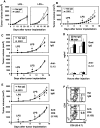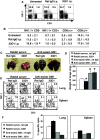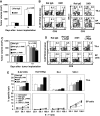Induction of tumor-specific acquired immunity against already established tumors by selective stimulation of innate DEC-205(+) dendritic cells
- PMID: 20221597
- PMCID: PMC2860563
- DOI: 10.1007/s00262-010-0835-z
Induction of tumor-specific acquired immunity against already established tumors by selective stimulation of innate DEC-205(+) dendritic cells
Abstract
Two major distinct subsets of dendritic cells (DCs) are arranged to regulate our immune responses in vivo; 33D1(+) and DEC-205(+) DCs. Using anti-33D1-specific monoclonal antibody, 33D1(+) DCs were successfully depleted from C57BL/6 mice. When 33D1(+) DC-depleted mice were stimulated with LPS, serum IL-12, but not IL-10 secretion that may be mediated by the remaining DEC-205(+) DCs was markedly enhanced, which may induce Th1 dominancy upon TLR signaling. The 33D1(+) DC-depleted mice, implanted with syngeneic Hepa1-6 hepatoma or B16-F10 melanoma cells into the dermis, showed apparent inhibition of already established tumor growth in vivo when they were subcutaneously (sc) injected once or twice with LPS after tumor implantation. Moreover, the development of lung metastasis of B16-F10 melanoma cells injected intravenously was also suppressed when 33D1(+) DC-deleted mice were stimulated twice with LPS in a similar manner, in which the actual cell number of NK1.1(+)CD3(-) NK cells in lung tissues was markedly increased. Furthermore, intraperitoneal (ip) administration of a very small amount of melphalan (L: -phenylalanine mustard; L: -PAM) (0.25 mg/kg) in LPS-stimulated 33D1(+) DC-deleted mice helped to induce H-2K(b)-restricted epitope-specific CD8(+) cytotoxic T lymphocytes (CTLs) among tumor-infiltrating lymphocytes against already established syngeneic E.G7-OVA lymphoma. These findings indicate the importance and effectiveness of selective targeting of a specific subset of DCs, such as DEC-205(+) DCs alone or with a very small amount of anticancer drugs to activate both CD8(+) CTLs and NK effectors without externally added tumor antigen stimulation in vivo and provide a new direction for tumor immunotherapy.
Figures






Similar articles
-
The boosting effect of co-transduction with cytokine genes on cancer vaccine therapy using genetically modified dendritic cells expressing tumor-associated antigen.Int J Oncol. 2006 Apr;28(4):947-53. Int J Oncol. 2006. PMID: 16525645
-
Rapid generation of potent and tumor-specific cytotoxic T lymphocytes by interleukin 18 using dendritic cells and natural killer cells.Cancer Res. 2000 Sep 1;60(17):4838-44. Cancer Res. 2000. PMID: 10987295
-
Optimal TLR9 signal converts tolerogenic CD4-8- DCs into immunogenic ones capable of stimulating antitumor immunity via activating CD4+ Th1/Th17 and NK cell responses.J Leukoc Biol. 2010 Aug;88(2):393-403. doi: 10.1189/jlb.0909633. Epub 2010 May 13. J Leukoc Biol. 2010. PMID: 20466823
-
[Mechanism of immune surveillance against HBV infection].Nihon Rinsho. 2004 Aug;62 Suppl 8:62-5. Nihon Rinsho. 2004. PMID: 15453287 Review. Japanese. No abstract available.
-
Modulation of innate immunity in the tumor microenvironment.Cancer Immunol Immunother. 2016 Oct;65(10):1261-8. doi: 10.1007/s00262-016-1859-9. Epub 2016 Jun 25. Cancer Immunol Immunother. 2016. PMID: 27344341 Free PMC article. Review.
Cited by
-
NK/DC crosstalk-modulating antitumor activity via Sema3E/PlexinD1 axis for enhanced cancer immunotherapy.Immunol Res. 2024 Dec;72(6):1217-1228. doi: 10.1007/s12026-024-09536-y. Epub 2024 Sep 5. Immunol Res. 2024. PMID: 39235526 Review.
-
Suppression of murine tumour growth through CD8+ cytotoxic T lymphocytes via activated DEC-205+ dendritic cells by sequential administration of α-galactosylceramide in vivo.Immunology. 2017 Jul;151(3):324-339. doi: 10.1111/imm.12733. Epub 2017 Apr 18. Immunology. 2017. PMID: 28294313 Free PMC article.
-
Oncolytic Rhabdovirus Vaccine Boosts Chimeric Anti-DEC205 Priming for Effective Cancer Immunotherapy.Mol Ther Oncolytics. 2020 Oct 14;19:240-252. doi: 10.1016/j.omto.2020.10.007. eCollection 2020 Dec 16. Mol Ther Oncolytics. 2020. PMID: 33209979 Free PMC article.
-
At the Bench: Chimeric antigen receptor (CAR) T cell therapy for the treatment of B cell malignancies.J Leukoc Biol. 2016 Dec;100(6):1255-1264. doi: 10.1189/jlb.5BT1215-556RR. Epub 2016 Oct 27. J Leukoc Biol. 2016. PMID: 27789538 Free PMC article. Review.
-
Benign lymph node microenvironment is associated with response to immunotherapy.Precis Clin Med. 2020 Mar;3(1):44-53. doi: 10.1093/pcmedi/pbaa003. Epub 2020 Feb 12. Precis Clin Med. 2020. PMID: 35693430 Free PMC article.
References
Publication types
MeSH terms
Substances
LinkOut - more resources
Full Text Sources
Research Materials
Miscellaneous

